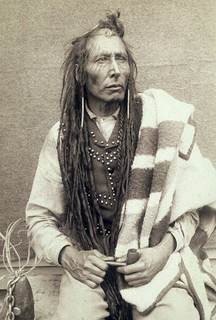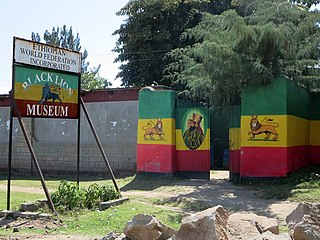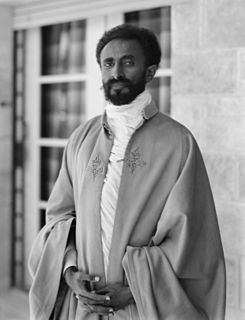
Haile Selassie I was Emperor of Ethiopia from 1930 to 1974. He rose to power as Regent Plenipotentiary of Ethiopia (Enderase) for Empress Zewditu from 1916. Haile Selassie is widely considered a defining figure in modern Ethiopian history, and the key figure of Rastafari, a religious movement in Jamaica that emerged shortly after he became emperor in the 1930s. He was a member of the Solomonic dynasty, which claims to trace lineage to Emperor Menelik I, believed to be the son of King Solomon and Makeda the Queen of Sheba.

Rastafari, sometimes called Rastafarianism, is a religion that developed in Jamaica during the 1930s. It is classified as both a new religious movement and a social movement by scholars of religion. There is no central authority in control of the movement and much diversity exists among practitioners, who are known as Rastafari, Rastafarians, or Rastas.

Dreadlocks, also known as locs or dreads, are rope-like strands of hair formed by locking or braiding hair.
The Holy Piby, also known as the Black Man's Bible, is a text written by an Anguillan, Robert Athlyi Rogers, for the use of an Afrocentric religion in the West Indies founded by Rogers in the 1920s, known as the Afro-Athlican Constructive Gaathly. The theology outlined in this work saw Ethiopians as the chosen people of God. The church preached self-reliance and self-determination for Africans, using the Piby as its guiding document.
Leonard Percival Howell, also known as The Gong or G.G. Maragh, was a Jamaican religious figure. According to his biographer Hélène Lee, Howell was born into an Anglican family. He was one of the first preachers of the Rastafari movement, and is known by many as The First Rasta.

Shashamane is a town in southern Ethiopia. Located in the Oromia Region with a 2007 Census population of 100,454, but with an estimated 208,368 inhabitants in mid 2022; the town is known for its Rastafarian community. The resort of Wondo Genet lies near Shashamane, as does the Senkele Wildlife Sanctuary.
Mortimo St George "Kumi" Planno, was a renowned Rastafari elder, drummer and a follower of the back-to-Africa movement founded in the 1910s by Marcus Garvey. He is best known as the Rasta teacher and friend of Bob Marley, and as the man who commanded the respect of a chaotic crowd during the arrival of Emperor Haile Selassie on his visit to Jamaica in 1966. He is referred to by other Rastas as a teacher and a leader within the context of the faith, given his life's work.
The Promised Key, sometimes known as The Promise Key, is a 1935 Rastafari movement tract by Jamaican preacher Leonard Howell, written under Howell's Hindu pen name G. G. Maragh.
Vernon Carrington founded the Twelve Tribes of Israel branch of the Rastafari movement in 1968. To his many followers across Jamaica and the world he was known as the Prophet Gad. Members of the Twelve Tribes of Israel view Carrington as a prophet who began the repatriation of Rastafari to Africa, the homeland. He was a member of The Ethiopian World Federation, founded by Emperor Haile Selassie of Ethiopia. Carrington's branch became The Twelve Tribes Of Israel, setting up at 83 Hope Road, Jamaica.

Mansions of Rastafari is an umbrella term for the various groups of the Rastafari movement. Such groups include the Bobo Ashanti, the Niyabinghi, the Twelve Tribes of Israel, and several smaller groups, including African Unity, Covenant Rastafari, Messianic Dreads and the Selassian Church. The term is taken from the Biblical verse in John 14:2, "In my Father's house are many mansions."
Grounation Day is an important Rastafari holy day, second only to Coronation Day. It is celebrated in honour of Haile Selassie's 1966 visit to Jamaica.
"War" is a song recorded and made popular by Bob Marley. It first appeared on Bob Marley and the Wailers' 1976 Island Records album, Rastaman Vibration, Marley's only top 10 album in the USA. The lyrics are almost entirely derived from a speech made by Ethiopian Emperor Haile Selassie I before the United Nations General Assembly on 4 October 1963.
The Rastafari Movement in the United States is the manifestation of the Rastafari Movement, founded in Jamaica, in the United States.
Persecution of members of the Rastafari movement, an Abrahamic religion founded in Jamaica in the early 1930s among Afro-Jamaican communities, has been fairly continuous since the movement began but nowadays is particularly concerning their spiritual use of cannabis.
Bongo Papa Noel Dyer I was a Jamaican Rastafarian elder known within the movement as the man who "walked to Ethiopia" after hitchhiking there, becoming in 1965 one of the first Rastas to settle on the Shashamane land granted in 1948 by the Rastafarian messiah, and Emperor of Ethiopia, Haile Selassie I. His story is featured prominently in The Emperor's Birthday, the 1993 documentary by John Dollar.

The Ethiopian World Federation Incorporated, (EWF) was a charitable organization established in the United States in 1937. Its aims were to mobilize support for the Ethiopians during the Italian invasion of 1935-41, and to embody the unity of Ethiopians home and abroad. Sections were established in other parts of the Americas. Later, the EWF was given charge of an area of land in Ethiopia for housing returning emigrants. EWF sections in different countries became increasingly identified with the African Diaspora movement even though it was originally aimed at African Americans ready to defend the Ethiopians subjects and their empire from the fascist aggressors.
Joseph Nathaniel Hibbert was, along with Leonard Howell, Archibald Dunkley, and Robert Hinds, one of the first preachers of the Rastafari movement in Jamaica following the coronation of Ras Tafari as Emperor Haile Selassie I of Ethiopia on 2 November 1930.
Abuna Yesehaq, was a leader of the Ethiopian Orthodox Tewahedo Church in the Western hemisphere.
Robert Athlyi Rogers, born in Anguilla, was the author of the Holy Piby, and founder of the "Afro-Athlican Constructive Church".
The Rastafari movement developed out of the legacy of the Atlantic slave trade, in which over ten million Africans were enslaved and transported to the Americas between the 16th and 19th centuries. Once there, they were sold to European planters and forced to work on the plantations. Around a third of these transported Africans were relocated in the Caribbean, with under 700,000 being settled in Jamaica. In 1834, slavery in Jamaica was abolished after the British government passed the Slavery Abolition Act 1833. Racial prejudice nevertheless remained prevalent across Jamaican society. The overwhelming majority of Jamaica's legislative council was white throughout the 19th century, and those of African descent were treated as second-class citizens.






